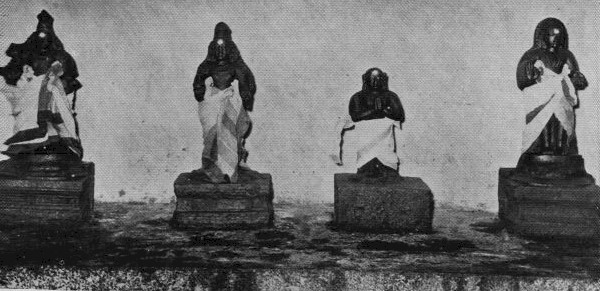Hymns
praising Tiruvarur have been composed by the
three primary Nayanmaars (Sambandar, Appar
and Sundarar) of the 63 Saivite Saints who led the Bhakti
movement of the 1st millennium CE. Apart from the moovar (trio),
several other Naayanmaars were also associated with the Tiruvarur
temple complex.

Tirugnanasambandar has composed 5
sets of patikams on Tiruvarur while Tirunavukkarasar and Sundarar
have composed 21 and 8 sets respectively.
Sambandar alludes to the Ardhanareeswara manifestation
of Shiva and refers to the female component of Ardhanareeswara as Alliyankodai.
Alliyankodai or Neelotpalaambal is regarded as
Vanmikanathar's consort and is housed in a separate shrine in the innerprecincts of the
temple. Sambandar's hymns refer to the natural beauty of the Tiruvarur
area and the tall structures adorned with flags that lined the town and to the music and
dance that filled the air.
Tirunavukkarasar refers to Vanmikanathar
as Putridamkondaan - referring to the legend of Shiva appearing in an ant hill. His hymns also describe
in detail the processional celebrations that marked the observance of Margazhi Tiruvaadirai and Panguni Utthiram
(which are celebrated today in great splendour).
Sundaramoorthy Nayanar's relationship to the deity Tyagaraja at Tiruvarur is in
a totally different vein. Sundarar alludes to Tyagaraja
as his friend or a companion who guided him through various events in his life. (See the
legend of Somaasi Maaranaar).
It was with the blessings of Tyagaraja at Tiruvarur
that Sundaramoorthy Nayanar married Paravai
Naachiyaar. Images of the devotee and his consort are offered an exalted
place in the temple, across from the shrine of Tyagaraja.
Closely associated with Sundaramoorthy Nayanar was Cheramaan
Perumaal another of the Nayanmaars. Cheramaan Perumaal a
ruler from Kerala had Kodungallur as his capital, and was closely
associated with the Shivastalam Tiruvanjaikkalam.
He composed the tamil work Tiruvaarur Mummanikkovai in the Nayakan-Nayaki
Bhavam, depicting the estranged female yearning for her beloved Tiruvaaruran.
The Tiruttondattogai of Sundarar lists the names of the 62
Nayanmars who preceded him. Sundarar along with the other 62
that he mentioned in his hymn on Tiruvarur constitute the arupattimoovar
or the 63 Saivite Saints whose life
history is described in detail in the Periya Puraanam - a colossal work
by Sekkizhaar a poet of the later Chola period.
Tirumoolar's work describes the Ajapaa dance associated
with Tyagaraja although it does not
directly allude to Tiruvarur. Maanikkavacakar's
Tiruvaacakam refers to Tiruvarur.
